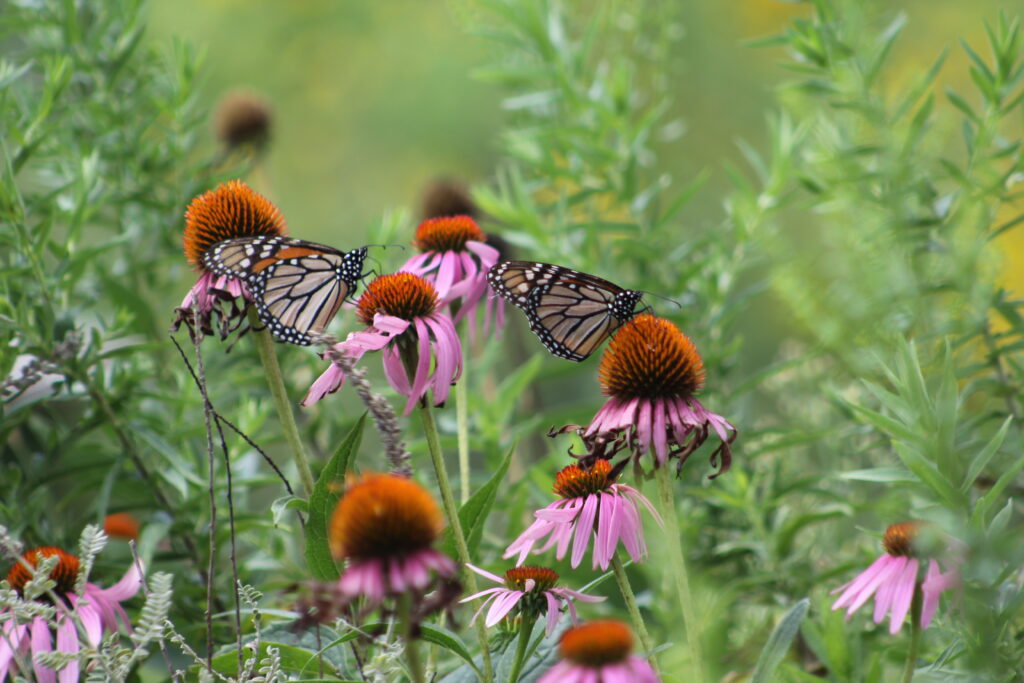Mace Tompson | Visitor Services – Gardens and Grounds
AmeriCorps Member, September 2023 – August 2024
Growing native plants in your garden can be as simple as sprinkling seeds onto a patch of dirt in fall and seeing what pops up in spring, or it can be more involved like starting seeds indoors at the end of winter and transplanting them into the garden after the last frost in spring. Whatever way you go about it, native plants are a great addition to any garden. Not only are they low maintenance once established, but they have many benefits to the ecosystem including providing food and habitat for wildlife. Their beauty is also unmatched, and they provide a sense of accomplishment when you see the plants you grew benefiting life all around you. If you don’t know where to start, here are three beautiful, beneficial and easy to grow native flowers you might want to look to add to your garden.

Milkweed is a very common and beloved native flower. Well known as the host plant to the monarch butterfly, milkweed provides a home and food for monarch caterpillars. Having evolved side by side, without milkweed, monarchs would go extinct. There is a variety of milkweed species, each being beautiful in their own way. Common milkweed (Asclepias syriaca) is a tall grower, with fragrant pink flowers. Butterfly milkweed (Asclepias tuberosa) is a shorter, bushier variety with vibrant orange blooms that are highly attractive to a multitude of pollinators. Whorled milkweed (Asclepias verticillata) is a white-flowered, medium-sized variety with thin leaves that is an adorable addition to any garden. With 12 varieties native to Wisconsin and many benefits for pollinators there’s no reason not to have this easy-growing plant in your garden.
Bee balm (Monarda fistulosa) is a favorite among bumble bees. When people talk about saving the bees it’s often in reference to honey bees, who are not being threatened by extinction like many native bees are. “There are likely more honey bees on the planet now than there ever have been in history,” Says Scott Black, the Executive Director of the Xerces Society, a nonprofit conservation organization that focuses on insects. One species that is in decline is the bumble bee. More than one-quarter of North American bumble bees are facing some sort of extinction risk*, not to mention many other bees and pollinators. Bee balm, also known as wild bergamot is a beautiful, pale purple flower that loves to stand tall amongst other plants. Its pollen and nectar feed many pollinators throughout the summer, while its seeds feed birds in fall and winter.

Purple coneflower (Echinacea purpurea) is an attractive, long blooming flower, typically blossoming from early Summer to Fall. It provides a reliable food source for pollinators, while also acts as the host plant for the silvery checkerspot butterfly. Lastly, it brings a nice pop of color for your garden! Purple coneflower benefits don’t stop after the blooms finish. It’s seed heads are a healthy food source for birds over winter. At the same time, its’ hollow stems provides a habitat for cavity nesting bees who lay eggs on pollen balls inside the stems. Eventually, the eggs develop into bees over a year long process, so it’s important not to cut back plants in the Fall to prep for your Spring garden.

Other easy-growing, beneficial natives include sweet joe-pye weed (Eupatorium purpureum), anise hyssop (Agastache foeniculum), wild petunia (Ruellia humilis) or one of the many species of goldenrod (Solidago spp.) or aster (Symphyotrichum spp.). Whether you’re growing a meadow full of native flowers, or a single pot on your apartment balcony, you’re making a difference and helping re-naturalize the world around us. With the massive decline in pollinators we’re currently facing due to habitat destruction, pollution, and pesticides, everyone needs to take an active part in protecting those we have left by providing food and shelter.
A few things to keep in mind when adding native plants to your garden are:
Bloom time: Many native gardeners group plants with varying blooming seasons, so there is always some available food in the garden for pollinators as they flower in succession to one another. For example, grouping golden alexander with common milkweed and New England aster will give you flowers all three seasons and ensure pollinators have food to eat at all times.
Pesticide usage: Many native plants are hardy when it comes to pests, and using pesticides on your native plants can end up harming the pollinators we set out to help. It’s often good to remember that what we consider “pests” are just another factor in our ecosystem. If something is eating your plants, you’ve created a healthy habitat for wildlife!
Sun, shade or partial: When planning your garden, it’s important to consider the sun exposure needs of each plant to ensure they thrive. Plants, such as milkweed and coneflower require full sun, so selecting a location with the appropriate amount of sunlight is essential. Additionally, be mindful of other conditions in your garden space, including soil type and moisture levels, to create a supportive environment for your native plants.

